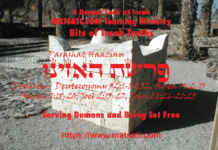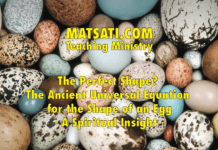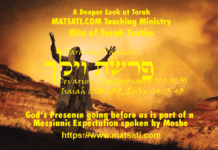This weeks reading is from Parashat Tetzave (Shemot / Exodus 27:20-30:10), which details the construction of the priestly garments. Aaron’s garments are said to consecrate him for the purpose of ministering before the Lord (28:3). The garments consist of the breast-piece, the ephod, a robe, a turban, and a sash (28:4). The ephod was constructed of two pieces connected at the ends (28:6). Two onyx stones contain the engraving of the names of the tribes of Israel (28:9). Twelve precious stones are set in the breast-piece one for each tribe (28:17-22). The Urim and Thummim are placed in the breast-piece so that they are over his heart continually. There is a golden plate engraved as a seal fastened to the front of the turban. The tunic is woven in a checkered fashion. The Lord tells Moshe to consecrate Aaron and his sons as priests with a bull and two rams without blemish (29:1), unleavened bread and unleavened cakes mixed with oil and unleavened wafers spread with oil all made of wheat flour. These are presented together before the Lord. Moshe brings Aaron and his sons to the entrance to the tent of meeting (29:4), dress them with the garments (29:5-6), and anoint them with oil (29:7), this being the process of ordination before God (29:9). The bull and two rams are slaughtered, the one ram is offered as a whole burnt offering, the second ram the blood is used to anoint Aaron and his sons, and the blood of the bull is placed upon the altar that is before God. The breast of the ram of their ordination, and the bread is made to be a wave offering before the Lord (29:26-28). The Lord says He will consecrate the tent of meeting, the altar, and the sons of Aaron as priests and the Parashah concludes with the Lord saying “I will dwell among the sons of Israel and will be their God.”
ספר שמות פרק כט
ל שבעת ימים ילבשם הכהן תחתיו מבניו אשר יבא אל אהל מועד לשרת בקדש: לא ואת איל המלאים תקח ובשלת את בשרו במקם קדש לב ואכל אהרן ובניו את בשר האיל ואת הלחם אשר בסל פתח אהל מועד: לג ואכלו אתם אשר כפר בהם למלא את ידם לקדש אתם וזר לא יאכל כי קדש הם: לד ואם יותר מבשר המלאים ומן הלחם עד הבקר ושרפת את הנותר באש לא יאכל כי קדש הוא:Shemot / Exodus 29:30-34
29:30 ‘For seven days the one of his sons who is priest in his stead shall put them on when he enters the tent of meeting to minister in the holy place. 29:31 ‘You shall take the ram of ordination and boil its flesh in a holy place. 29:32 ‘Aaron and his sons shall eat the flesh of the ram and the bread that is in the basket, at the doorway of the tent of meeting. 29:33 ‘Thus they shall eat those things by which atonement was made at their ordination and consecration; but a layman shall not eat them, because they are holy. 29:34 ‘If any of the flesh of ordination or any of the bread remains until morning, then you shall burn the remainder with fire; it shall not be eaten, because it is holy. (NASB)
Studying the Aramaic translations, the Targum Pseudo-Jonathan and Neofiti provide us with some interesting insights into this verse from Shemot / Exodus 29:33 on eating the things by which atonement was made at their ordination and consecration.
Targum Neofiti
לג ויאכלון יתהון די יכפר אתכפר בהון למשלמה ית קרבן ידיהון למקדשא יתהון וחילוניי לא יאכל ארי קדש אינון׃Targum Pseudo Jonathan
לג וייכלון יתהון דאתכפר בהון לקרבא ית קרבנהון למקדשא יתהון לשמשא קדמי וחילוני לא ייכול ארום קודשא הינון:
The Targum Pseudo-Jonathan states “ויאכלון יתהון די יכפר” meaning “and you are to eat the one who atones,” “בהון למשלמה” “with regard to being complete/to come true/scripture being fulfilled or made perfect,” “ית קרבן ידיהון למקדשא” “at the hand of the sacrifice which sanctifies you.” It is important to note when studying Hebrew and Aramaic, that in the Semitic languages, word order may be used to place emphasis upon a particular aspect of what is being said or written. Here in Targum Pseudo Jonathan, the text states “ית קרבן ידיהון למקדשא” “at the hand of the sacrifice which sanctifies you” where the Aramaic word order is different from that of the English translation. The Aramaic word ית is used to introduce the direct object (Sacrifice). This is synonymous to the Hebrew word את used to introduce the same (a direct object) in Hebrew grammar. Note again how the word order is reversed in Aramaic as compared to the English translation. Also, this word is not translated into English as a definite direct object marker because the English language accomplishes this by word order in the same way that Hebrew and Aramaic do with the words את and ית respectively. (Take for example, the sentence “The dog bites the man.” If we change the word order in English to “The man bites the dog,” the meaning of the sentence changes. This is not so in Hebrew and Aramaic since את or ית is placed before the object. The sentence would be written in Aramaic as “The dog bites ית the man.” Therefore, one is able to give emphasis on the man by changing the word order saying “ית the man bites the dog” and the person reading or listening would still understand the dog is biting the man regardless of the word order.) The Aramaic translation (Targum Neofiti specifically) states that the priest is to eat “ית the sacrifice” so that “the scriptures may be fulfilled or made perfect.” Emphasis is placed upon the sacrifice, consumption, and the fulfilling of the Scriptures. Eating the sacrifice incorporates (internalizes) the thing that brought atonement making it a part of the body and a part of one’s life. Quite literally the life of the animal is laid down as a substitute for our lives; the Priest bears the iniquity of the sacrifice and then makes atonement before God in the Tabernacle. This is done in the place and the way that God requires. In the Torah, the Lord intended that the sacrificial laws given to the Priests would foreshadow the coming atoning sacrifice offered by Yeshua, “the Lamb of God slay from the foundation (יסוד) of the world” (1 Peter 1:19-20, Revelation 13:8). Like the emphasis here in this weeks reading on the Sacrifice, throughout Scripture emphasis is placed upon the sacrifice from the Lord, the True Lamb of God, Yeshua the Messiah! BTT_Parashat Tetzave-2014








